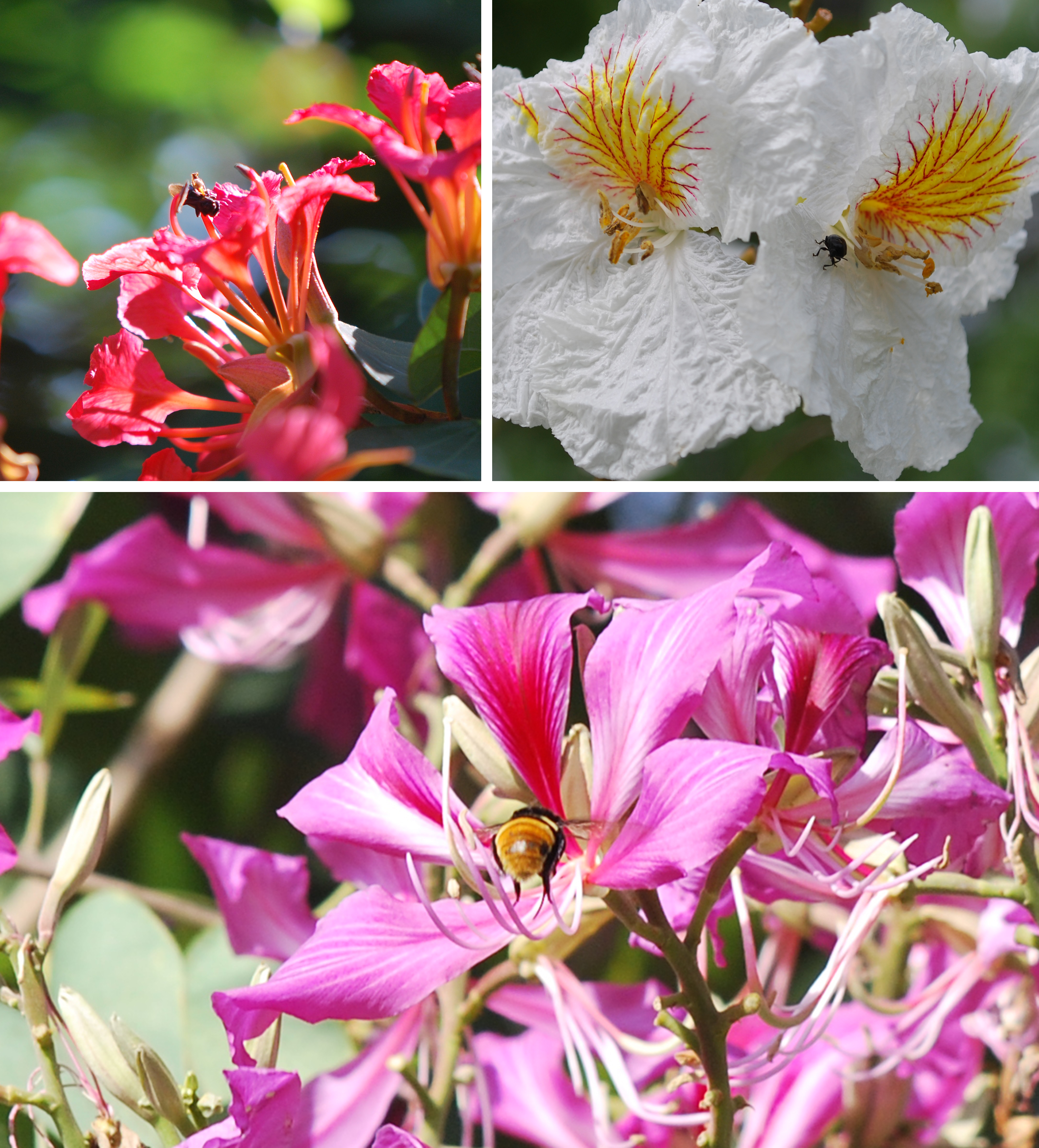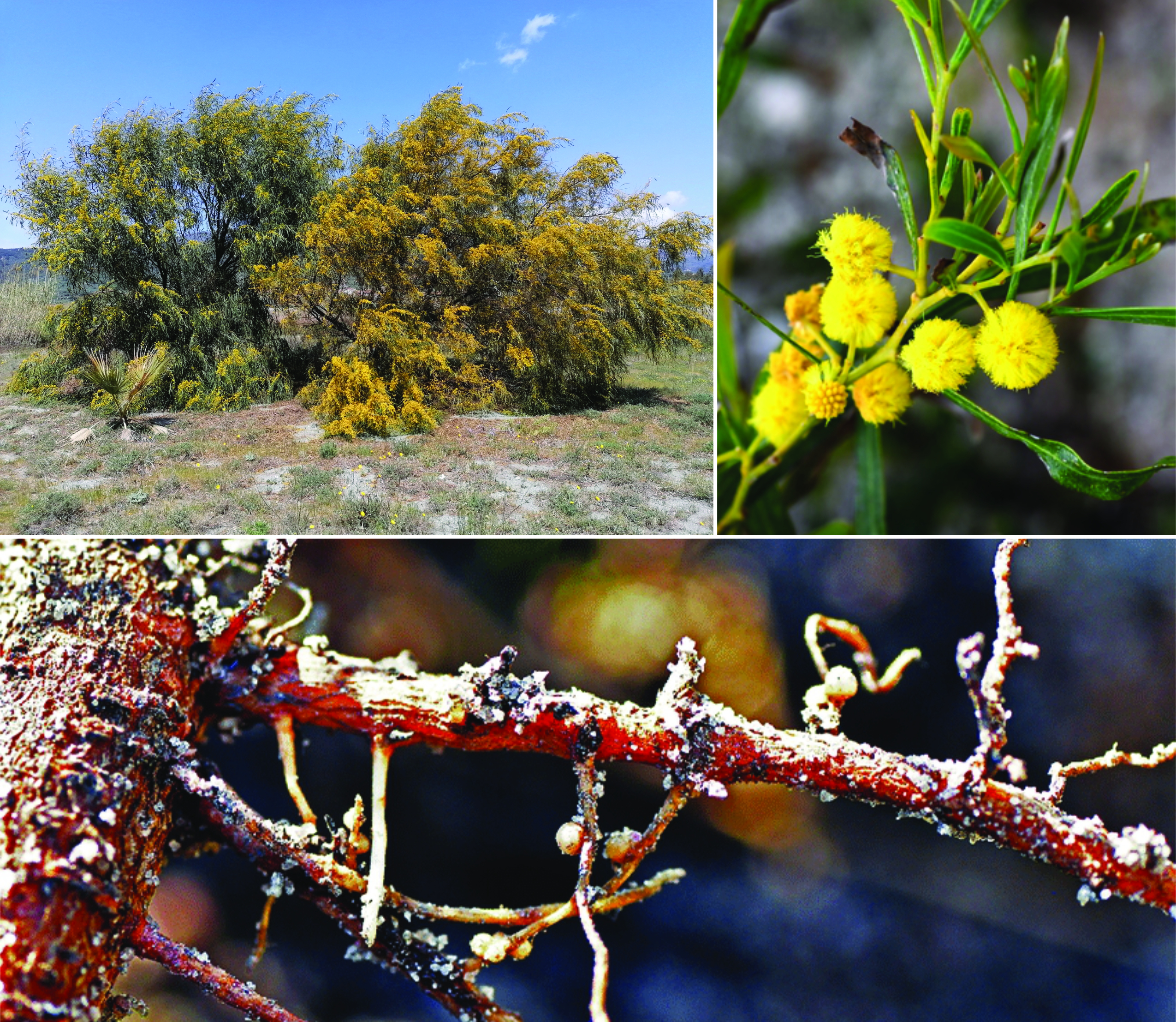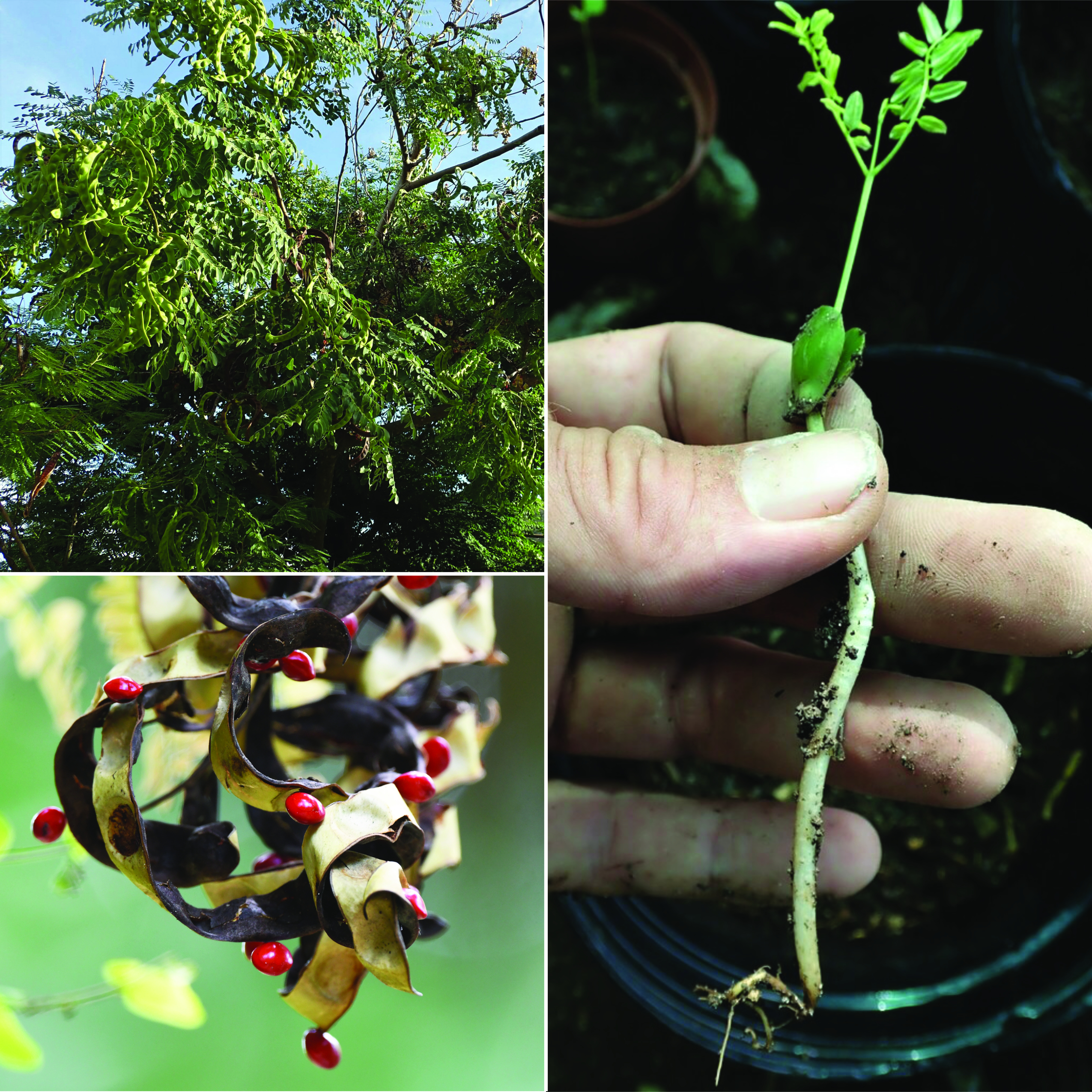STUDENT DIGESTS
MORPHOLOGY AND EVOLUTION OF FLORAL NECTARIES IN LEGUMES
Andrews Vinicius Silva (PhD candidate, Escola Nacional de Botânica Tropical, Instituto de Pesquisas Jardim Botânico do Rio de Janeiro, Brazil)
Despite the importance of nectar for plant reproduction and the long history of research on floral nectaries, there are still gaps in understanding their development and evolutionary origins. These gaps may be addressed through comparative morphological and evolutionary analyses based on precise hypotheses of homology. However, the terminology used to describe floral nectaries is often confusing and inconsistent. There is also controversy regarding the presence of nectaries in the flowers of certain species. To tackle these issues, Sinjushin (2024) set out to review the current state of knowledge on floral nectaries in legumes.
Leguminosae floral nectaries exhibit remarkable variation in location (Caspary, 1848; Sinjushin et al., 2022), shape (Sirichamorn et al., 2014), and symmetry (Teuber et al., 1980; Sinjushin, 2021). Their common anatomical structure includes modified stomata (Picklum, 1954; Konarska, 2020). Nectar secretion originates in the parenchyma (Fahn, 1979; Valtueña et al., 2007) and is sometimes released by unusual mechanisms, such as cell rupture (Leite et al., 2021).
The development of floral nectaries reportedly occurs late in floral ontogeny (Picklum, 1954), with the timing of nectar secretion varying among species (Davis and Gunning, 1992). Nectar storage, protection, and availability are crucial, with various adaptations to prevent loss (Fahn, 1972; Hopkins, 1984) and to ensure its accessibility to pollinators (Rodríguez-Riaño et al., 1999).
The loss of floral nectaries has occurred repeatedly in legumes, often accompanied by heterostameny (Paulino et al., 2016) and the presence of alternative food sources for pollinators, such as other specialized organs (Stone et al., 2003; de Barros and Teixeira, 2016) or extrafloral nectaries (Knox et al., 1985; Stone et al., 2003).
Exudate composition is influenced by both environmental factors (Vansell, 1941) and genetics (Walker et al., 1974; Cocucci et al., 1992). Phylogeny (van Wyk, 1993; Koptur, 1994) and pollination strategies (Mitchell, 2004; Agostini et al., 2011) also play potential roles in determining its composition.
The origin of floral nectaries in Leguminosae is still debated. Some researchers suggest they derive from stamens (Moore, 1936), while others propose multiple independent origins (Waddle and Lersten, 1973; Sinjushin, 2021). Their presence is considered ancestral in the order Fabales (Bernardello, 2007), and their absence in various groups is interpreted as independent losses (Schneider, 2007). However, the morphological variability of floral nectaries, combined with the challenges of studying them (Stirton, 1981; Sirichamorn et al., 2014), has resulted in these organs being rarely used in legume systematics.
 Examples of legume species with floral nectaries. Top left: Bauhinia galpinii; top right: Bauhinia uruguayensis; bottom: Bauhinia variegata.
Examples of legume species with floral nectaries. Top left: Bauhinia galpinii; top right: Bauhinia uruguayensis; bottom: Bauhinia variegata.
While Leguminosae floral nectaries exhibit notable evolutionary stability, the reasons for their absence in certain lineages remain unresolved. A comprehensive understanding of the diversity, function, and genetic and physiological mechanisms underlying the development of floral nectaries is crucial to addressing these questions. Sinjushin’s (2024) exploration of previously overlooked aspects of floral nectary morphology and evolution highlights potential pathways for clarifying the diversity and significance of this ecologically important organ in the context of the Leguminosae.
References
Agostini, K.; Sazima, M.; Galetto, L. 2011. Nectar production dynamics andsugar composition in two Mucuna species (Leguminosae, Faboideae) withdifferent specialized pollinators. Naturwissenschaften, v. 98, p. 933–942.
Bernardello, G. 2007. A systematic survey of floral nectaries. In: Nicolson,S. W.; Nepi, M.; Pacini, E. (eds.). Nectaries and nectar. Dordrecht:Springer, p. 19–128.
Caspary, R. 1848. De nectariis. Bonn: Schellhoff.
Cocucci, A. A.; Galetto, L.; Sersic, A. 1992. El síndrome floralde Caesalpinia gilliesii (Fabaceae-Caesalpinioideae). Darwiniana, v.31, p. 111–135.
Davis, A. R.; Gunning, B. E. S. 1992. The modified stomata of the floral nectary of Vicia faba L. 1. Development, anatomy and ultrastructure. Protoplasma, v. 166, p. 134–152.
De Barros, T. C.; Teixeira, S. P. 2016. Revisited anatomy of anther glands in mimosoids (Leguminosae). International Journal of Plant Sciences, v. 177, p. 18–33.
Fahn, A. 1972. Plant anatomy. 3rd ed. Oxford: Pergamon Press, p. 413–422.
Fahn, A. 1979. Ultrastructure of nectaries in relation to nectar secretion. American Journal of Botany, v. 66, p. 977–985.
Hopkins, H. C. 1984. Floral biology and pollination ecology of the Neotropical species of Parkia. Journal of Ecology, v. 72, p. 1–23.
Knox, R. B. et al. 1985. Extrafloral nectaries as adaptations for bird pollination in Acacia terminalis. American Journal of Botany, v. 72, p. 1185–1196.
Konarska, A. 2020. Microstructure of floral nectaries in Robinia viscosa var. hartwigii (Papilionoideae, Fabaceae) – a valuable but little-known melliferous plant. Protoplasma, v. 257, p. 421–437.
Koptur, S. 1994. Floral and extrafloral nectars of Costa Rican Inga trees: a comparison of their constituents and composition. Biotropica, v. 26, p. 276–284.
Leite, V. G. et al. 2021. Resolving the non-papilionaceous flower of Camoensia scandens, a papilionoid legume of the core genistoid clade: development, glands and insights into the pollination and systematics of the group. Journal of Plant Research, v. 134, p. 823–839.
Mitchell, R. J. 2004. Heritability of nectar traits: why do we know so little? Ecology, v. 85, p. 1527–1533.
Moore, J. A. 1936. The vascular anatomy of the flower in the papilionaceous Leguminosae. II. American Journal of Botany, v. 23, p. 349–355.
Paulino, J. V.; Mansano, V. F.; Prenner, G. 2016. Evidence for division of labor and division of function related to pollen release in Papilionoideae (Leguminosae) with a heteromorphic androecium. International Journal of Plant Sciences, v. 177, p. 590–607.
Picklum, W. E. 1954. Developmental morphology of the inflorescence and flower of Trifolium pratense L. Iowa State College Journal of Science, v. 28, p. 477–495.
Rodríguez-Riaño, T.; Ortega-Olivencia, A.; Devesa, J. A. 1999. Types of androecium in the Fabaceae of SW Europe. Annals of Botany, v. 83, p. 109–116.
Schneider, J. V. 2007. Surianaceae. In: Kubitzki, K. (ed.). Flowering Plants. Eudicots. The families and genera of vascular plants. v. 9. Berlin, Heidelberg: Springer, p. 449–455.
Sinjushin, A.; Ploshinskaya, M.; Maassoumi, A. A.; Mahmoodi, M.; Bagheri, A. 2022. Variations in structure among androecia and floral nectaries in the Inverted Repeat-Lacking Clade (Leguminosae: Papilionoideae). Plants, v. 11, p. 649.
Sinjushin, A. 2021. Evolutionary history of the leguminous flower. Biology Bulletin Reviews, v. 11, p. 400–413.
Sinjushin, A. 2024. Floral nectaries in Leguminosae: structure, diversity, and possible evolution. The Botanical Review, v. 90, n. 3, p. 251–311.
Sirichamorn, Y.; Adema, F. A. C. B.; Roos, M. C.; Van Welzen, P. C. 2014. Molecular and morphological phylogenetic reconstruction reveals a new generic delimitation of Asian Derris (Fabaceae): Reinstatement of Solori and synonymization of Paraderris with Derris. Taxon, v. 63, p. 522–538.
Stirton, C. H. 1981. The Eriosema cordatum complex. II. The Eriosema cordatum and E. nutans groups. Bothalia, v. 13, p. 281–306.
Stone, G. N.; Raine, N. E.; Prescott, M.; Willmer, P. G. 2003. Pollination ecology of acacias (Fabaceae, Mimosoideae). Australian Systematic Botany, v. 16, p. 103–118.
Teuber, L. R. et al. 1980. Structure of floral nectaries of alfalfa (Medicago sativa L.) in relation to nectar production. American Journal of Botany, v. 67, p. 433–439.
Valtueña, F. J.; Ortega-Olivencia, A.; Rodríguez-Riaño, T. 2007. Nectar production in Anagyris foetida (Fabaceae): two types of concentration in flowers with hanging droplets. International Journal of Plant Sciences, v. 168, p. 627–638.
Van Wyk, B. E. 1993. Nectar sugar composition in Southern African Papilionoideae (Fabaceae). Biochemical Systematics and Ecology, v. 21, p. 271–277.
Vansell, G. H. 1941. Alfalfa nectar and the honeybee. Journal of Economic Entomology, v. 34, p. 21–23.
Waddle, R. M.; Lersten, N. R. 1973. Morphology of discoid floral nectaries in Leguminosae, especially tribe Phaseoleae (Papilionoideae). Phytomorphology, v. 23, p. 152–161.
Walker, A. K.; Barnes, D. K.; Furgala, B. 1974. Genetic and environmental effects on quantity and quality of alfalfa nectar. Crop Science, v. 14, p. 235–238.
EVOLUTIONARY HISTORY AND ROOT TRAIT COORDINATION PREDICT NUTRIENT STRATEGY IN TROPICAL LEGUME TREES
Lydia K. Madika (PhD Student, University of Cape Town, South Africa)
Tropical forests are characterized by a rich diversity of tree species, including legumes, which are key players in nutrient cycling because of their unique ability to convert atmospheric nitrogen into forms usable by plants (Brookshire et al., 2019). However, these trees face challenges in acquiring both nitrogen and phosphorus, with phosphorus often being limited in availability (Townsend et al., 2008). To overcome these challenges, tropical trees have evolved distinct root traits and diverse symbiotic relationships (e.g., Fig.1). In this context, root diversity varies along two primary axes: collaboration with mycorrhizal fungi and a trade-off between nutrient acquisition and conservation (Weemstra et al., 2016; McCormack & Iversen, 2019; Bergmann et al., 2020; Weigelt et al., 2021). Despite this understanding, there remains a notable gap in data regarding physiological root traits that influence plant functions, highlighting the necessity for evolutionary and functional approaches, particularly among closely related species. The legume family serves as an excellent model to fill these gaps, as its species have diverse strategies for nutrient acquisition (Ardley & Sprent, 2021). Moreover, recent phylogenetic analyses suggest that ecological niche may be a more reliable predictor of traits than genetic relatedness, and the exploration of phosphorus acquisition in tropical Fabaceae adds further complexity, underscoring the need for larger species samples to conduct comprehensive analyses.
In a recent study, Marcellus et al. (2024), investigated a range of traits related to root morphology, physiology, and symbiosis of 22 species of Fabaceae trees from in tropical and subtropical regions. Specifically, they aimed to understand the phylogenetic distribution of nutrient-acquisition traits, compare nitrogen-fixing species with non-fixing ones, and explore potential trade-offs and relationships between these traits. To achieve this, they conducted a thorough analysis of various traits, including specific root length, root tissue density, nitrogen content in roots, respiration rates, phosphatase activity, mycorrhizal colonization, nitrogen-fixation rates, and nodule biomass. They also looked at aboveground traits like photosynthetic assimilation rates and specific leaf area.
 Acacia saligna, a nitrogen-fixing legume. Top left: Habit. Top right: Blooms. Bottom: Root system highlighting nodules formed through symbiotic nitrogen-fixing bacteria. Photos by tgregor (top left), lamprisdimitris (top right) and Hongtao (bottom).
Acacia saligna, a nitrogen-fixing legume. Top left: Habit. Top right: Blooms. Bottom: Root system highlighting nodules formed through symbiotic nitrogen-fixing bacteria. Photos by tgregor (top left), lamprisdimitris (top right) and Hongtao (bottom).
The study uncovered significant variation in fine root traits among the species, supporting the idea that there is considerable diversity within this group. Interestingly, the researchers found evidence of phylogenetic conservatism in some nutrient-acquisition traits, suggesting that evolutionary history influences these characteristics. They also noted clear differences between nitrogen-fixing and non-fixing species, with nitrogen-fixers exhibiting higher phosphatase activity, which aligns with the nutrient-trading hypothesis (Houlton et al., 2008). However, it’s important to mention that the connection between nitrogen fixation and phosphatase activity was not mechanistic; instead, it appeared to be an evolutionarily conserved trait.
 Adenanthera pavonina, a non-nitrogen-fixing legume. Top left: Habit. Bottom left: Fruit. Right: Seedling without nodules, indicating the absence of symbiotic nitrogen-fixing bacteria.
Adenanthera pavonina, a non-nitrogen-fixing legume. Top left: Habit. Bottom left: Fruit. Right: Seedling without nodules, indicating the absence of symbiotic nitrogen-fixing bacteria.
Connecting the detailed exploration of root traits and evolutionary history, the study by Marcellus et al. enriches our comprehension of nutrient strategies in tropical legume trees. This comprehensive approach highlights the importance of root traits, which are often underutilized in evolutionary studies, and demonstrates how both evolutionary history and functional traits collectively shape plant nutrient strategies in diverse ecosystems. These integrated insights provide a foundation for refining nutrient cycling and plant adaptation models, broadening our understanding of the complex dynamics within tropical forest ecosystems.
References
Ardley, J., Sprent, J. 2021. Evolution and biogeography of actinorhizal plants and legumes: a comparison. Journal of Ecology 109:1098-1121.
Bergmann, J., Weigelt, A., van der Plas, F., Laughlin, D.C., Kuyper, T.W., Guerrero-Ramirez, N., Valverde-Barrantes, O.J., Bruelheide, H., Freschet, G.T., Iversen, C.M., Kattge, J., McCormack, M.L., Meier, I., Rillig, M.C., Roumet, C., Semchenko, M., Sweeney, C.J., van Ruijven, J., York, L.M., Mommer, L. 2020. The fungal collaboration gradient dominates the root economics space in plants. Science Advances 6:eaba3756.
Brookshire, E.N.J., Wurzburger, N. Currey, B., Menge, D.N.L., Oatham, M.P., Roberts, C. 2019. Symbiotic N fixation is sufficient to support net aboveground biomass accumulation in a humid tropical forest. Scientific Reports 9: 7571.
Houlton, B.Z., Wang, Y.-P., Vitousek, P.M., Field, C.B. 2008. A unifying framework for dinitrogen fixation in the terrestrial biosphere. Nature 454: 327-330.
Marcellus, M., Goud, E.M., Swartz, N., Brown., Soper, F.M. 2024. Evolutionary history and root trait coordination predict nutrient strategy in tropical legume trees. New Phytologist 243: 1711–1723. Doi: 10.1111/nph.19962.
McCormack, M.L., Iversen, C.M. 2019. Physical and functional constraints on viable belowground acquisition strategies. Frontiers in Plant Science 10: 1215.
Townsend, A., Asner, G., Cleveland, C. 2008. The biogeochemical heterogeneity of tropical forests. Trends in Ecology & Evolution 23: 424–431.
Weemstra, M. Mommer, L. Visser, E.J.W. van Ruijven, J. Kuyper, T.W., Mohren, G.M.J., Sterck, F.J. 2016. Towards a multidimensional root trait framework: a tree root review. New Phytologist 211: 1159–1169.
Weigelt, A., Mommer, L., Andraczek, K., Iversen, C.M., Bergmann, J., Bruelheide, H., Fan, Y., Freschet, G.T., Guerrero-Ramirez, N.R., Kattge, J. Kuyper, T.W., Laughlin, D.C., Meier, I.C., van der Plas, F., Poorter, H., Roumet, C., van Ruijven, J., Sabatini, F. M., Semchenko, M., Sweeney, C.J., Valverde-Barrantes, O.J., York, L.M., McCormack, M.L. 2021. AN integrated framework of plant form and function: the belowground perspective. New Phytologist 232: 42–59.